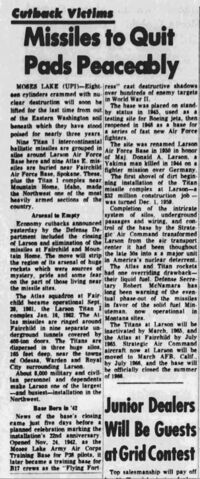1964-11-20-sc-p19-closing-of-larson-titan-force
November 20, 1964 Spokane Daily Chronicle Page 19:
Cutback Victims
Missiles to Quit Pads Peaceably
MOSES LAKE (UPI)—Eighteen cylinders crammed with nuclear destruction will soon he lifted for the last time from out of the Eastern Washington soil beneath which they have stood poised for nearly three years.
Nine Titan I intercontinental ballistic missiles are grouped in silos around Larson Air Force Base here and nine Atlas E missiles are buried near Fairchild Air Force Base, Spokane. These plus the Titan I complex near Mountain Home, Idaho, made the northwest on of the most heavily armed sections of the country.
Arsenal is Empty
Economy cutbacks announced yesterday by the Defense Department included the closing of Larson and elimination of the missiles at Fairchild and Mountain Home, The move will strip the region of its arsenal of huge rockets which were sources of mystery, pride and some fear on the part of those living near the missile sites.
The Atlas squadron at Fairchild became operational Sept. 28, 1961. the Larson Titan I complex Jan. 16, 1962. The Atlas missiles are ringed around Fairchild in nine separate underground tunnels covered by 400-ton doors. The Titans are dispersed in three huge silos of Odessa, Warden, and Royal City surrounding Larson.
About 8,000 military and civilian personnel and dependents make Larson on of the largest and busiest—installation in the Northwest.
Base Born in 1942
News of the base's closing came just five days before a planned celebration marking installation’s 22nd anniversary. Opened Nov. 24, 1942, as the Moses Lake Army Air Corps Training Base for P38 pilots, it later became a training base for B17 crews as the "Flying Fortress" cast destructive shadows over hundreds of enemy targets in World War II.
The base was placed on standby status in 1945, used as a testing site for Boeing jets, then reopened in 1948 as a base for a series of fast new Air Force fighters.
The base was renamed Larson Air Force Base in 1859 in honor of Maj. Donald A, Larson, a Yakiama man killed in 1944 on a fighter mission over Germany
The first shovel of dirt beginning installation of the Titan missile complex at Larson—a $32 million construction job—was turned Dec. 1, 1959.
Completion of the intricate system of silos, underground passages and wiring, and control of the base by the Strategic Air Command transformed Larson from the air transport center it had been throughout the late 50s into a major unit in America's nuclear deterrent.
The Atlas and Titan rockets had one overriding drawback—their liquid fuel. Defense Secretary Robert McNamara has long been warning of the eventual phase-out of the missiles in favor of the solid fuel Minuteman, now operational in Montana sites.
The Titans at Larson will be inactivated by March, 1965, and the Atlas at Fairchild by July, 1965, Strategic Air Command aircraft now at Larson will be moved to March AFB, Calif., by July 1966, and the base will be officially closed the summer of 1966.
